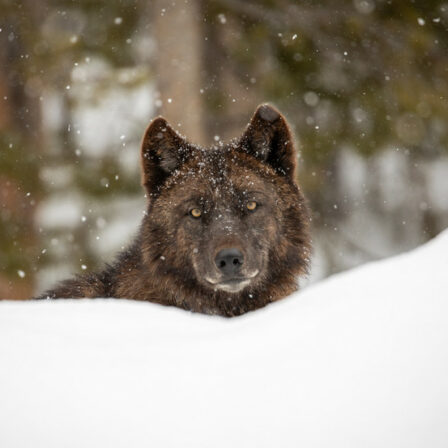For Release: Thursday, January 27, 2022
Over 81,000 demand support for long-term Mexican gray wolf conservation
Enormous outpouring of public support backs majority public opinion that Mexican gray wolves need stronger protections.
SANTA FE, NM—Over 81,000 people called on the U.S. Fish & Wildlife Service (USFWS) to establish stronger protections for endangered Mexican gray wolves. During a 90-day public comment period on proposed changes to a management rule that determines their recovery success, supporters of wolves returning to the southwestern U.S. submitted an estimated 81,000 comments. Over 47,000 were submitted through the regulations.gov site with another 34,000 individuals signing on to conservation organization letters submitted.
“On top of a heap of scientific literature, we once again see immense public support for real lobo recovery. That means allowing wolves to re-establish throughout their historic range, rescuing them from genetic crisis, and designating them as essential,” said Chris Smith, southwest wildlife advocate for WildEarth Guardians. “For the American public and for wolves, U.S. Fish and Wildlife needs to get it right this time.”
The comments consistently referenced vital changes:
- The USFWS must designate wild Mexican gray wolves as “essential.” Since the beginning of reintroduction, wolves have been listed as “nonessential,” which must change immediately to give wolves the legal protections they need to recover.
- Rather than trying to manage the Mexican wolf population around an average of 320 wolves, which will be inadequate to ensure resilience, USFWS should instead focus on establishing a larger metapopulation consisting of at least 750 wolves in at least three interconnected U.S. populations. There should not be a cap or maximum number of Mexican wolves allowed in the wild. The best wolf scientists in the world say we need more wolves in more places to ensure long-term survival.
- USFWS must do more to meaningfully and measurably address the genetic crisis faced by Mexican gray wolves. These rare wolves need immediate genetic rescue that must be directly assessed, not simply modeled. Genetic rescue can best be achieved through a combination of the release of well-bonded wolf families from the Mexican Wolf Species Survival Plan (SSP) captive breeding program along with cross-fostering of captive-born pups into wild packs. Relying on cross-fostering alone is insufficient. Further, released wolves should only count toward genetic objectives if they survive and reproduce in the wild, as that is the only way to ensure they have contributed their genes to the wild population.
- USFWS must do more to work with partner agencies like the U.S. Forest Service to require non-lethal prevention of conflicts between wolves and livestock, to increase capacity for community outreach to educate people about the presence of Mexican gray wolves and their protected status, and to prevent wolf removals due to livestock conflict as well as illegal killing. Robust law enforcement mechanisms must be in place, and strict penalties must be enforced if illegal killing does occur.
- Wolves should not be removed from the wild because they roamed beyond a geographic boundary, particularly for traveling into or inhabiting suitable habitats north of Interstate Highway 40.
- Mexican gray wolves belong in Mexico too. Recovery efforts should facilitate natural connectivity between wolves in the U.S. and Mexico.
- The USFWS must be proactive in supporting wolves to establish new packs and populations in additional areas, including areas deemed important for wolf recovery like the Grand Canyon Ecoregion and the Southern Rockies.
The comments demonstrate a large majority support for USFWS shifting focus toward measurable, science-based objectives to support the long-term conservation of Mexican wolves rather than short-term (and short-sighted) steps that will be inadequate to ensure recovery. In addition, polling shows more than two-thirds of voters in Arizona and New Mexico support wolf reintroduction, reflected in comments from diverse stakeholders.
“Americans again voiced overwhelming support for science-based recovery of the iconic Mexican gray wolf. It is well past time for the Fish and Wildlife Service to listen. It is time for the symbol of the Southwest to once again roam free,” said Patricia Estrella, New Mexico representative for Defenders of Wildlife.
“Mexican wolves cannot afford another weak ineffective rule that ignores the best science. Wolves need to be allowed to disperse and thrive and play their truly essential role in our southwestern wildlands, said Sandy Bahr, chapter director for Sierra Club’s Grand Canyon (Arizona) Chapter. “The US Fish and Wildlife Service must fulfill its responsibility to these endangered animals and come back with a rule that will ensure healthy, sustainable populations of Mexican wolves.”
“If it fails the science test, it fails the Lobo,” said Maggie Howell, the Wolf Conservation Center executive director. “That’s why the American public is saying loud and clear that they expect USFWS to follow the best available science to ensure that the Mexican gray wolf remains a living, breathing part of the southwestern landscape.”
USFWS tried to make changes to the “10(j) Management Rule” in 2015 (Endangered and Threatened Wildlife and Plants; Revision to the Regulations for the Nonessential Experimental Population of the Mexican Wolf ; Federal Register/Vol. 80, No. 11/Friday, January 16, 2015, pp.2512-2567). However, the changes they proposed were woefully inadequate. As a result, conservation organizations immediately sued USFWS for not fulfilling their obligation to bring Mexican gray wolves back to a healthy wild population. The court agreed with the groups; U.S. District Court Judge Jennifer Zipps came back with an order for the USFWS to redo the process of changing the management rule and this time include correct interpretations of the best available science.
Once again, the USFWS has failed to follow the court order and the science in their proposed 10(j) Rule, and again, scientists, conservation organizations, and concerned members of the public have emphasized that Mexican gray wolves do not have the luxury of time in their race against extinction. Therefore, USFWS cannot delay taking the necessary steps to ensure their recovery any longer.
“The keys to Mexican wolf recovery are well understood: reduce anthropogenic mortality and increase genetic diversity,” said Michelle Lute, PhD in human-wolf coexistence and national carnivore conservation manager for Project Coyote. “USFWS has yet to demonstrate capacity or willingness to meet their recovery duties. Proactive actions like releasing bonded mates with pups and reforming livestock husbandry practices are essential to recovery of this essential lobo population.”
A timeline was set by Judge Zipps, stating her concern for an immediate need of changes to be implemented for the survival of the species. Her timeline requires an Environmental Impact Statement, sufficient public review, and a Final Rule to be completed by July 1, 2022.
Background on Mexican Gray Wolves:
The lobo, or Mexican gray wolf, is the smallest, most genetically distinct, and one of the rarest subspecies of gray wolf. They were listed under the Endangered Species Act in 1976, but recovery efforts have suffered without implementation of recovery actions recommended by wildlife advocates.
Mexican wolves are at tremendous risk due to their small population size, limited gene pool, threats from trapping, and illegal killings. As of the last official count in 2020, there are 186 known Mexican gray wolves in the wild in the U.S. More at www.mexicanwolves.org.
CONTACTS:
Chris Smith, Southwest Wildlife Advocate, WildEarth Guardians, 505-395-6177, [email protected]
Sandy Bahr, Chapter Director for Sierra Club’s Grand Canyon (Arizona) Chapter, 602-999-5790, [email protected]
Patricia Estrella, Representative, New Mexico, Defenders of Wildlife, 505-395-7334, [email protected]
Maggie Howell, Executive Director, Wolf Conservation Center, 914-763-2373 ext 200, [email protected]
Michelle Lute, National Carnivore Conservation Manager, Project Coyote, 406-848-4910, [email protected]
# # #





0 comments on “81,000+ demand support for long-term Mexican gray wolf conservation”